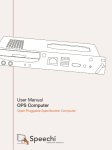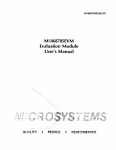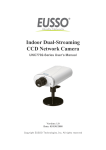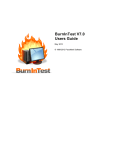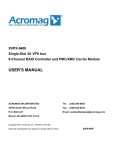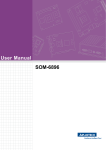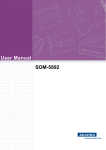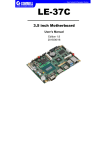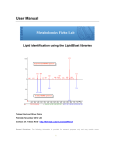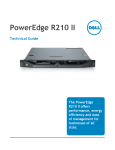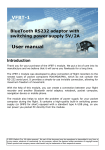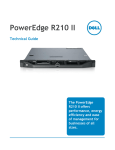Download Example User Manual
Transcript
XCOM-6400 Intel® 4th Generation Core COM Express CPU Module USER’S MANUAL ACROMAG INCORPORATED 30765 South Wixom Road Wixom, MI 48393-2417 U.S.A. Tel: (248) 295-1541 Fax: (248) 624-9234 Copyright 2015, Acromag, Inc., Printed in the USA. Data and specifications are subject to change without notice. 8501003G USER MANUAL XCOM-6400 Table of Contents 1.0 GENERAL INFORMATION............................................................................................ 5 1.1 Intended Audience .......................................................................................................5 1.2 Preface .........................................................................................................................5 1.2.1 Trademark, Trade Name and Copyright Information ....................................................................... 5 1.2.2 Class A Product Warning ................................................................................................................... 5 1.2.3 Environmental Protection Statement ............................................................................................... 5 1.3 Product Summary .........................................................................................................6 1.4 Related Material...........................................................................................................7 1.5 Ordering Information ...................................................................................................7 1.6 Key Features and Benefits ............................................................................................8 1.6.1 1.6.2 1.6.3 1.6.4 1.6.5 Fig. 1.6.a: XCOM-6400 Block Diagram ........................................................................................... 8 Intel® 4th Gen (Haswell) Core CPU ................................................................................................... 8 Intel QM87 Chipset (Lynx Point) PCH ................................................................................................ 9 Intel I217 PHY .................................................................................................................................. 10 Nuvoton NCT6776D Super-I/O ........................................................................................................ 10 Atmel AT97SC3204 TPM ................................................................................................................. 10 2.0 PREPARATION FOR USE........................................................................................... 11 2.1 Unpacking and Inspecting ........................................................................................... 11 2.2 Carrier Board Considerations ...................................................................................... 12 2.3 Carrier Board Installation............................................................................................ 12 2.4 Default Hardware Configuration ................................................................................. 12 3.0 HARDWARE INFORMATION AND CONFIGURATION....................................... 13 3.1 Module Hardware Configuration ................................................................................ 13 Fig. 3.1.a: XCOM-6400 Without Heat Spreader Top View ........................................................ 13 Fig. 3.1.b: XCOM-6400 Bottom View ........................................................................................... 13 Table 3.1.a: Configuration Switches .......................................................................................... 14 3.2 Power Supply and Management ................................................................................. 14 Acromag, Inc. Tel: 248-295-1541 -1--1- http://www.acromag.com www.acromag.com USER MANUAL XCOM-6400 3.2.1 Power Options ................................................................................................................................ 14 3.2.2 Programmable CPU Power Limits ................................................................................................... 15 3.2.3 Power Management ....................................................................................................................... 16 3.3 CPU ............................................................................................................................ 17 3.3.1 Active Processor Core Selection ...................................................................................................... 18 3.3.2 Turbo Boost Configuration .............................................................................................................. 18 3.4 Platform Controller Hub (PCH) .................................................................................... 18 3.5 System Memory ......................................................................................................... 19 3.6 Video ......................................................................................................................... 19 3.6.1 Display Configuration and Resolution ............................................................................................. 19 Table 3.6.1.a: Valid Three Display Configuration through the Processor .................................... 19 3.6.2 PCI Express Graphics (PEG) ............................................................................................................. 20 3.6.3 VGA ................................................................................................................................................. 21 3.6.4 Digital Display Interfaces ................................................................................................................. 21 3.6.5 Embedded DisplayPort .................................................................................................................... 23 3.6.6 Configuring the Primary Display ..................................................................................................... 23 3.6.7 Configuring the Video Memory....................................................................................................... 23 3.6.8 Video Display Options ..................................................................................................................... 23 3.7 Intel® High Definition Audio ........................................................................................ 24 3.8 Storage I/O ................................................................................................................. 24 3.8.1 SATA ................................................................................................................................................ 24 3.9 General I/O ................................................................................................................ 24 3.9.1 General Purpose I/O (GPIO) ............................................................................................................ 24 3.9.2 SMBus and I2C ................................................................................................................................ 25 Table 3.9.2.a: SMBus/I2C Address Table ................................................................................... 25 3.9.3 Low Pin Count (LPC) ........................................................................................................................ 25 3.9.4 PCI Express ...................................................................................................................................... 26 3.9.5 Serial Ports ...................................................................................................................................... 26 3.9.6 SPI Flash .......................................................................................................................................... 26 3.9.7 USB .................................................................................................................................................. 27 3.9.7.1 Configuring USB Ports .................................................................................................................. 27 3.10 Ethernet ................................................................................................................... 27 3.10.1 Configuring Wake On LAN ............................................................................................................. 28 3.10.2 Configuring PXE Boot .................................................................................................................... 28 3.11 Real Time Clock (RTC) ............................................................................................... 28 Acromag, Inc. Tel: 248-295-1541 -2--2- http://www.acromag.com www.acromag.com USER MANUAL XCOM-6400 3.12 Security .................................................................................................................... 28 3.12.1 Trusted Platform Support ............................................................................................................. 28 3.12.2 Password Control .......................................................................................................................... 28 3.13 System Management ................................................................................................ 29 3.13.1 3.13.2 3.13.3 3.13.4 3.13.5 3.13.6 3.13.7 3.13.8 Intel® Hyper-Threading Technology ............................................................................................... 29 Enhanced Intel® SpeedStep Technology (EIST) .............................................................................. 29 Intel® Virtualization Technology (Intel VT-x and VT-d) .................................................................. 29 Intel® Trusted Execution Technology (TXT) ................................................................................... 30 Intel® Turbo Boost Technology ...................................................................................................... 30 Intel® Active Management Technology ......................................................................................... 31 Intel® Matrix Storage Technology.................................................................................................. 31 Intel® Configurable TDP Technology ............................................................................................. 31 3.14 Thermal Management .............................................................................................. 31 3.14.1 3.14.2 3.14.3 3.14.4 3.14.5 Fan Speed ...................................................................................................................................... 32 Thermal Monitoring ...................................................................................................................... 32 Thermal Throttling ........................................................................................................................ 32 Memory Throttling ........................................................................................................................ 32 Thermal Management Hardware .................................................................................................. 32 Fig. 3.14.5.a XCOM-6400 without Thermal Management Hardware ....................................... 33 Fig. 3.14.5.b XCOM-6400 and Heat Spreader ......................................................................... 33 Fig. 3.14.5.c Module Mounting Screw Locations ....................................................................... 34 Fig. 3.14.5.d SODIMM Assembly................................................................................................ 35 Fig. 3.14.5.e XCOM-6400 with Heat Spreader and Active Heat Sink ...................................... 36 Fig. 3.14.5.f XCOM-6400, ACEX-4620 Carrier Board, and Heat Spreader Assembly ......... 37 3.15 Watchdog ................................................................................................................. 37 4.0 BIOS INFORMATION AND CONFIGURATION ..................................................... 38 4.1 XCOM-6400 Special BIOS Features .............................................................................. 38 Fig. 4.1.a Acromag BIOS Setup Menu .......................................................................................... 38 Fig. 4.1.b Acromag BIOS Setup Menu - GPO2.............................................................................. 38 Fig. 4.1.c Acromag BIOS Setup Menu - GPO3 .............................................................................. 39 Fig. 4.1.d Acromag BIOS Setup Menu - GPI3 ............................................................................... 39 Fig. 4.1.e Advanced BIOS Setup Menu - i217 LAN Port Configuration ........................................ 40 Fig. 4.1.f Advanced BIOS Setup Menu - i217 NIC Configuration .................................................. 40 4.2 Drivers and Utilities .................................................................................................... 40 5.0 SERVICE AND REPAIR ............................................................................................... 41 5.1 Service and Repair Assistance ..................................................................................... 41 Acromag, Inc. Tel: 248-295-1541 -3--3- http://www.acromag.com www.acromag.com USER MANUAL XCOM-6400 5.2 Preliminary Service Procedure .................................................................................... 41 5.3 Where to Get Help...................................................................................................... 41 6.0 SPECIFICATIONS ......................................................................................................... 42 6.1 Physical ...................................................................................................................... 42 6.1.1 J3 Connector ................................................................................................................................... 42 6.1.2 J4 Connector ................................................................................................................................... 42 6.2 Power Requirements .................................................................................................. 42 6.3 Environmental Considerations .................................................................................... 43 6.4 Reliability Prediction .................................................................................................... 44 Table 6.4.a MTBF ......................................................................................................................... 44 6.5 Certificate of Volatility ................................................................................................ 44 APPENDIX A: COM-EXPRESS CONNECTOR (J4) PINOUT TABLE .......................... 44 REVISION HISTORY ............................................................................................................ 48 Acromag, Inc. Tel: 248-295-1541 -4--4- http://www.acromag.com www.acromag.com USER MANUAL XCOM-6400 1.0 GENERAL INFORMATION 1.1 Intended Audience This users’ manual was written for technically qualified personnel who will be working with I/O devices using the XCOM-6400 CPU. It is not intended for a general, non-technical audience that is unfamiliar with computer-on-module (COM) devices and their application. 1.2 Preface The information contained in this manual is subject to change without notice, and Acromag, Inc. (Acromag) does not guarantee its accuracy. Acromag makes no warranty of any kind with regard to this material, including, but not limited to, the implied warranties of merchantability and fitness for a particular purpose. Further, Acromag assumes no responsibility for any errors that may appear in this manual and makes no commitment to update, or keep current, the information contained in this manual. No part of this manual may be copied or reproduced in any form, without the prior written consent of Acromag, 1.2.1 Trademark, Trade Name and Copyright Information © 2014 by Acromag Incorporated. All rights reserved. Acromag and Xembedded are registered trademarks of Acromag Incorporated. All other trademarks, registered trademarks, trade names, and service marks are the property of their respective owners. 1.2.2 Class A Product Warning This is a Class A product. In a domestic environment this product may cause radio interference, in which case the user may find it necessary to take adequate corrective measures. 1.2.3 Environmental Protection Statement This product has been manufactured to satisfy environmental protection requirements where possible. Many components used (structural parts, circuit boards, connectors, batteries, etc.) are capable of being recycled. Final disposition of this product after its service life must be conducted in accordance with applicable country, state, or local laws or regulations. Acromag, Inc. Tel: 248-295-1541 -5--5- http://www.acromag.com www.acromag.com USER MANUAL XCOM-6400 1.3 Product Summary COM ExpressTM is an open-industry standard for computer-on-modules (COMs). These are highly-integrated and compact PCs that can be used in a design application much like an integrated circuit component. Each COM Express module integrates core CPU and memory functionality, the common I/O of a PC/AT, USB, audio, graphics (PEG), and Ethernet. All I/O signals are mapped to two high density, low profile connectors on the bottom side of the module. The XCOM-6400 uses an Intel® 4th Generation Core Processor (Haswell) module in a Type 6 COM Express basic form factor (125mm x 95mm). It fully conforms to Revision 2.1 of the COM Express Module Base Specification except those signals noted in Appendix A. The module can support either one or two DDR3L ECC SODIMMs, for a total of up to 16GB. The SODIMMs are firmly attached to the module with screws and surrounded by heat sink material to provide a mechanically and thermally robust mechanism. Extended temperature models are available for operating in a -40°C to +85°C range. A large amount of I/O is available, as summarized in the “Key Features and Benefits” section below. A two digit LED display is available for Power ON Self-Test (POST) codes, should a problem arise during the boot operation. This display is available for application software user codes after POST to aid in software debugging. A 26-pin XDP debug connector is also available for connecting compatible emulator tools directly to the CPU. For more information see Intel publication 479493, Shark Bay and Denlow Platforms Debug Port Design Guide. All functional I/O and input power are available on the COM-Express Connector (J4). In order for this module to function and to gain access to the I/O it must be installed in a Type 6 R2.0 or R2.1 Com Express carrier board. WARNING: The XCOM-6400 must be installed onto a Type 6 carrier board conforming to R2.0 or R2.1 of the Com-Express Specification. Damage to the module and/or carrier may result if used with another carrier. Acromag, Inc. Tel: 248-295-1541 -6--6- http://www.acromag.com www.acromag.com USER MANUAL XCOM-6400 1.4 Related Material The following manuals and part specifications provide the necessary information for in-depth understanding of the XCOM-6400 module. COM-Express Module Base Specification Rev. 2.1 http://www.picmg.org The Acromag APTIO Core BIOS Manual For Acromag Products Referred to hereafter as The APTIO Core BIOS Manual For Acromag Products. Intel® document No. 328901, “Mobile 4th Generation Intel® Core™ Processor Family Datasheet – Volume 1 of 2”, Rev: 002; September, 2013. http://www.intel.com/content/www/us/en/processors/core/CoreT echnicalResources.html ACEX-4600-EDK User's Manual ACEX-4605/4610/4620 User's Manual 1.5 Ordering Information When ordering the XCOM-6400-ABBD-X COM Express module, please select from and specify the available option choices (A, BB, D and X) as defined below (such as XCOM-6400-304-LF, etc.): Acromag, Inc. Tel: 248-295-1541 Select the CPU option (A): 1: 47W, i7-4700EQ, 2.4GHz, quad core, 6MB Cache 3: 25W, i5-4402E, 1.6GHz, dual core, 3MB Cache Select the memory option (B); 04: 4GB 08: 8GB 16: 16GB Select the operating environment (temperature) option (D): Blank: Standard temperature operation E: Extended temperature operation Select the solder option (X): L: Leaded solder (not available – consult factory) LF: Lead-free solder -7--7- http://www.acromag.com www.acromag.com USER MANUAL XCOM-6400 1.6 Key Features and Benefits The XCOM-6400 block diagram shown in Fig. 1.6.1 illustrates the key components and features that are summarized on the following pages. Fig. 1.6.a: XCOM-6400 Block Diagram 1.6.1 Intel® 4th Gen (Haswell) Core CPU Available as either a 2.4GHz quad-core i7 or a 1.6GHZ dual-core i5. This 64bit, 22-nanometer (Haswell) CPU with integrated GT2 graphics contains direct interfaces for DDR3L, DDI, and PCIe x16, all of which are available on the COM Express connector. In addition, the Direct Media Interface (DMI) is used to connect to the QM87 Platform Control Hub (PCH). DDR3L SDRAM – Two SODIMM sockets support up to 16GB of DDR3L ECC at 1600MHz. Dual-channel mode is used with the two SODIMMs. The SODIMMs are attached to the module firmly with screws and surrounded by heat sink material to provide a robust Acromag, Inc. Tel: 248-295-1541 -8--8- http://www.acromag.com www.acromag.com USER MANUAL XCOM-6400 mechanism both mechanically and thermally. PCIe x16 – Traditionally used for external graphics, but supports any PCIe device(s). Can also be split into two x8 interfaces or one x8 and two x4 interfaces. DDI (3) – These Digital Display Interfaces can be configured to be DisplayPort 1.2, DVI, or HDMI. eDP – Embedded DisplayPort allows direct connection to a display panel using up to two lanes for communication. Backlight and voltage enable lines are also available. Programmable CPU power limits – By simply programming a lower power limit in the BIOS setup, the CPU can be used in applications where less power is available or heat removal is an issue. This is accomplished by the CPU automatically underclocking its frequency to maintain a power level at the set limit. 1.6.2 Intel QM87 Chipset (Lynx Point) PCH The Intel 8 Series QM87 (Lynx Point) PCH provides extensive I/O support, all of which is available on the COM-EXPRESS connector and is listed below: PCIe (7) – There are seven lanes of PCIe available in addition to the x16 from the CPU. SATA III (4) – There are four SATA ports that operate up to 6Gb/sec. USB 3.0 (4) – There are four ports available that support USB 3.0 speed. These ports are backwards compatible to USB 2.0 and USB 1.1. USB 2.0 (4) – There are four additional ports that function at USB 2.0 or USB 1.1 speeds. VGA – An analog VGA port is available, including DDC clock and data. GPIN (4) – There are four 3.3V general purpose inputs available. Do not exceed 3.6V or the module may be damaged. GPOUT (4) – There are up to four 3.3V general purpose outputs available. WDTO – This Watchdog Timer Output indicates a watchdog timeout event has occurred. This output remains high until cleared by module software. LPC – Low Pin Count bus allows connection of slower devices on the carrier, typically Super-I/O or TPM devices. SPI – The Serial Peripheral Interface is used for the onboard boot flash. This interface is available on the carrier for connection of other user flash devices. Note that booting from carrier SPI is not supported by the module. HDA Audio – The HDA audio port is available to compatible CODECs on the carrier. I2C – This I2C bus is available for general user devices. It also contains an onboard EEPROM for module identification. Note that Acromag, Inc. Tel: 248-295-1541 -9--9- http://www.acromag.com www.acromag.com USER MANUAL XCOM-6400 to access this bus from the PCH the connection must first be enabled in the PCA9540 (see below). SMBUS – This I2C-compatible System Management Bus is available to the carrier, but care should be taken not to interfere with any devices on the module. 1.6.3 Intel I217 PHY The Intel I217 is a single-port Gigabit Ethernet Physical Layer Transceiver (PHY). It connects to the PCH’s integrated Media Access Controller (MAC) through a dedicated interconnect. It supports 10/100/1000 Mb/s data rates and is available on the COM-Express connector. 1.6.4 Nuvoton NCT6776D Super-I/O The Nuvoton NCT6776D is an LPC device that provides temperature and voltage monitoring, Port 80 debug via 2 digit 7-segment display, and the following signals available on the COM-Express connector: Serial Port (2) – 2 16550-compatible serial ports (TX/RX only). CPU Fan Tach/PWM – Supplies PWM signal for fan control and receives tach output from fan for speed monitoring. 1.6.5 Atmel AT97SC3204 TPM The Atmel AT97SC3204 is a fully integrated security module that implements version 1.2 of the Trusted Computing Group (TCG) specification for Trusted Platform Modules (TPM). The TPM includes a cryptographic accelerator capable of computing a 2048-bit RSA signature in 200ms and a 1024-bit RSA signature in 40ms. Performance of the SHA-1 accelerator is 20μs per 64-byte block. Acromag, Inc. Tel: 248-295-1541 - 10 -- 10 - http://www.acromag.com www.acromag.com USER MANUAL XCOM-6400 2.0 PREPARATION FOR USE IMPORTANT PERSONAL AND PRODUCT SAFETY CONSIDERATIONS It is very important for the user to consider the possible safety implications of power, wiring, component, sensor, or software failures in designing any type of control or monitoring system. This is especially important where personal injury or the loss of economic property or human life is possible. It is important that the user employ satisfactory overall system design. It is understood and agreed by the Buyer and Acromag that this is the Buyer's responsibility. WARNING: This board utilizes static sensitive components and should only be handled at a static-safe workstation. This product is an electrostatic sensitive device and is packaged accordingly. Do not open or handle this product except at an electrostatic-free workstation. Additionally, do not ship or store this product near strong electrostatic, electromagnetic, magnetic, or radioactive fields unless the device is contained within its original manufacturer’s packaging. Be aware that failure to comply with these guidelines will void the Acromag Limited Warranty. 2.1 Unpacking and Inspecting Upon receipt of this product, inspect the shipping carton for evidence of mishandling during transit. If the shipping carton is badly damaged or water stained, request that the carrier's agent be present when the carton is opened. If the carrier's agent is absent when the carton is opened and the contents of the carton are damaged, keep the carton and packing material for the agent's inspection. For repairs to a product damaged in shipment, refer to the Acromag Service Policy to obtain return instructions. It is suggested that salvageable shipping cartons and packing material be saved for future use in the event the product must be shipped. This board is physically protected with packing material and electrically protected with an anti-static bag during shipment. However, it is recommended that the board be visually inspected for evidence of mishandling prior to applying power. Acromag, Inc. Tel: 248-295-1541 - 11 -- 11 - http://www.acromag.com www.acromag.com USER MANUAL XCOM-6400 2.2 Carrier Board Considerations Refer to the specifications section for loading and power requirements. Be sure that the system power supplies are able to accommodate the power requirements of the system boards, plus the installed Acromag board, within the voltage tolerances specified. In an air cooled assembly, the optional active heatsink must be used and adequate air circulation must be provided to prevent a temperature rise above the maximum operating. If the installation is in an industrial environment and the board is exposed to environmental air, careful consideration should be given to air-filtering. In a conduction cooled assembly, adequate thermo conduction must be provided to prevent a temperature rise above the maximum operating temperature. 2.3 Carrier Board Installation Remove power from the system before installing the CPU module onto the carrier board using the supplied M2.5x8 screws. Note 2.4 Default Hardware Configuration If necessary, the XCOM Express module may need to be configured differently than as received, depending on the application. When the module is shipped from the factory, it is configured as follows: PEG port configuration: 2 x8 ports. For information on reconfiguring the PEG port see Section 3.1, “Module Hardware Configuration.” PCIE port configuration: PCIE(0:3): x4, PCIE4: x1, PCIE5: x1, PCIE6: x1; For information on reconfiguring the PCIE ports see Section 3.9.4, “BIOS Information and Configuration.” Acromag, Inc. Tel: 248-295-1541 - 12 -- 12 - http://www.acromag.com www.acromag.com USER MANUAL XCOM-6400 3.0 HARDWARE INFORMATION AND CONFIGURATION 3.1 Module Hardware Configuration Fig. 3.1.a: XCOM-6400 Without Heat Spreader Top View Fig. 3.1.b: XCOM-6400 Bottom View Acromag, Inc. Tel: 248-295-1541 - 13 -- 13 - http://www.acromag.com www.acromag.com USER MANUAL XCOM-6400 Table 3.1.a summarizes the functions, settings, and descriptions for dip switches SW1-1 thru SW1-4. Configuration Switches Table 3.1.a: Configuration Switches Position Function Switch Setting Description 1:2 PEG Port Bifurcation/ Trifurcation 3 ME RTC Reset BIOS/PCH RTC Reset OFF:OFF OFF:ON ON:OFF ON:ON OFF ON OFF ON PEG is 1 x 16 PEG is 2 x 8 Reserved PEG is 1 x8, 2 x4 Normal Operation Clears ME Normal Operation Clears BIOS/RTC 4 SW1-1 and SW1-2 control PEG port Bifurcation: The PEG port can be configured as: a single x16 port, two x8 ports, or 1 x8 port and two x4 ports. In this last case the x8 port uses lanes 0-7, the first x4 port uses lanes 8-11, and the second x4 port uses lanes 12-15. SW1-3 is used to clear the PCH Management Engine (ME) settings. To clear these settings, close the switch and then open it again. Note: After clearing the ME settings, the RTC settings must also be cleared by closing SW1-4 and opening it again. If SW1-4 is not closed and reopened AFTER opening SW1-3, the module may not boot. SW1-4 is used to clear the BIOS setup configuration as well as internal PCH registers connected to the RTC voltage. To clear these settings, close the switch and then open it again before use. Note that leaving the board unplugged from a carrier that supplies the RTC voltage for several hours will also clear these settings. 3.2 Power Supply and Management 3.2.1 Power Options When using the Acromag ACEX-46XX carrier board, the carrier provides a 12V plus 5V standby power supply to the system module. When using a carrier board other than the ACEX-46XX, the module can be powered from either the 12V only, or 12V plus 5V standby power source. WARNING: The XCOM-6400 must be installed onto a Type 6 carrier board conforming to R2.0 or R2.1 of the Com-Express Specification. Damage to the module and/or carrier may result if used with another carrier. Acromag, Inc. Tel: 248-295-1541 - 14 -- 14 - http://www.acromag.com www.acromag.com USER MANUAL XCOM-6400 3.2.2 Programmable CPU Power Limits The XCOM-6400 features programmable power limits, allowing the user to 'dial-down' the maximum power consumption of the CPU in systems where power is a concern. The graph below shows that the i7-4700EQ CPU outperforms other available embedded Intel CPU's at every power point from 5W - 47W, even the i5-4402E, which can also use the programmable power limits. i7-4700EQ (5-47W) CPU Mark i5-4402E (5-25W) i7-3612QE (35W) i7-3615E (45W) i7-3517UE (17W) Atom E3845 (10W) Power Rating or Throttle Setting (W) By simply programming a lower power limit in the BIOS setup, the CPU can be used in applications where less power is available or heat removal is an issue. This is accomplished by the CPU automatically underclocking its frequency to maintain a power level at the set limit. Note: Once the minimum frequency of 800MHz is reached the programmed limit could be exceeded. Extremely large workloads have a realistic minimum power of around 20W. However light to medium workloads can effectively maintain a power limit as low as 5-10W. There are two programmable CPU limits. These are the long-term average Power Limit 1 (PL1) and the short-term Power Limit 2 (PL2). Depending on a windowed Power Limit 1 Time 'constant', the CPU can spend a short time above power level PL1 up to a maximum of PL2, allowing a significant performance boost for short workloads. If the CPU power remains above PL1 at the end of this time the power is then limited back to PL1. The power must drop below the PL1 limit before it allowed to increase back to PL2 again. For time spent above PL1 an equivalent amount of time must be spent below PL1 in order for it to rise again to PL2. The maximum time could be as much 2.5x the value of the PL1 Time. The default values for each CPU are as follows: Acromag, Inc. Tel: 248-295-1541 - 15 -- 15 - http://www.acromag.com www.acromag.com USER MANUAL XCOM-6400 CPU I7-4700EQ I5-4402E PL1 47W 25W PL2 59W 31W Tau 28 seconds 28 seconds PL1 and PL2 can be programmed in watts to any value below the default. Entering a value above the default will result in the default value being used. Entering 0 also results in the default value being used. PL1 Time can be programmed to any number of seconds up to 256, however it is recommended by Intel to always use the default value of 28. This value maximizes the effectiveness of the short-term performance boost while ensuring that the life of the part is not jeopardized by spending too much time above PL1. More details about programming these power limits using the BIOS setup utility are provided in The APTIO Core BIOS Manual For Acromag Products. 3.2.3 Power Management The XCOM-6400 module uses the Advanced Configuration and Power Interface (ACPI) 3.0 standard to provide user-managed power via the operating system, contingent upon the carrier board selected. 3.2.3.1 ACPI System States The five ACPI “Supported Module States” are described as follows: G0/S0: Fully operational; the main memory is being used for all work. S3: Standby; the main memory is still powered up, but the work is suspended to RAM. Work will be resumed exactly where it was stopped when standby was initiated. S4 — Hibernate; all work and content residing in the main memory is saved to a non‐volatile memory media, and the main memory is then powered down. S5: Soft off. Power is removed from all devices, including the main memory, RAM, and all volatile memory devices. This results in all memory content being lost. G3: Unpowered. Power has been mechanically removed from the system. Wake‐up is not possible in this state. Note that all of these states are supported with the Acromag ACEX-46XX carrier boards but may not be with other carriers. An ACPI-aware operating system must be installed and either 5V Standby or 12V must remain applied to the module at all times for S3, S4, or S5 support. 3.2.3.2 ACPI Wake-Up Events The XCOM-6400 module supports the following wake‐up events from the S3, S4, and S5 power states if 12V operating power or 5V standby power are Acromag, Inc. Tel: 248-295-1541 - 16 -- 16 - http://www.acromag.com www.acromag.com USER MANUAL XCOM-6400 provided by the power supply: Power button Wake On LAN (instructions can be found in Section 3.10.1, “Configuring Wake On LAN”). RTC alarm (instructions can be found in Section 3.11, “Real Time Clock (RTC)”. PCI and PCI Express power management event signaling; PME wake‐up is enabled by default. 3.2.3.3 ACPI Processor States The Advanced Configuration and Power Interface (ACPI) provides an open standard for device configuration and power management by the operating system. More details about this feature are provided in The APTIO Core BIOS Manual For Acromag Products. 3.3 CPU The Intel® Gen 4 (Haswell) CPU is available as either a 2.4GHz quad-core i7 or a 1.6GHZ dual-core i5. This 64-bit, 22-nanometer CPU with integrated GT2 graphics contains direct interfaces for DDR3L, DDI, and PCIe x16, all of which are available on the COM-Express connector. In addition, the Direct Media Interface (DMI) is used to connect to the QM87 Platform Control Hub (PCH). DDR3L SDRAM – 2 SODIMM sockets support up to 16GB of DDR3L ECC at 1600MHz. Dual-channel mode is used with 2 SODIMMs. The SODIMMs are attached to the module firmly with screws and surrounded by heat sink material to provide a robust mechanism both mechanically and thermally. PCIe x16 – This is traditionally used for external graphics, but supports any PCIe device(s). It can also be split into 2 x8 interfaces or 1 x8 and 2 x4 interfaces, as selected by SW1-1 and SW1-2. See Section 3.2, “Module Hardware Configuration.” DDI (3) – These Digital Display Interfaces can be configured to be Displayport 1.2, DVI, or HDMI. Three simultaneous displays are possible. See Section 3.7.1, “Display Configuration and Resolution”, for a list of valid combinations. eDP – The embedded DisplayPort allows direct connection to a display panel using up to two lanes for communication. Backlight and voltage enable lines are also available, and up to two other simultaneous displays are possible. See Section 3.7.1, “Display Configuration and Resolution”, for a list of valid combinations. Programmable CPU power limits – By simply programming a lower power limit in the BIOS setup, the CPU can be used in applications where less power is available or heat removal is an issue. This is accomplished by the CPU automatically underclocking its frequency to maintain a power level at the set limit. Acromag, Inc. Tel: 248-295-1541 - 17 -- 17 - http://www.acromag.com www.acromag.com USER MANUAL XCOM-6400 3.3.1 Active Processor Core Selection All of the CPU cores should be kept active in high-performance systems requiring all available computing power. Conversely, applications having reduced power requirements can save power by disabling one or more of the CPU cores. The number of active CPU cores can be specified in the CPU configuration menu. More details about this feature are provided in The APTIO Core BIOS Manual For Acromag Products. 3.3.2 Turbo Boost Configuration By default Turbo Mode is enabled in the BIOS setup screen. Turbo Mode allows the CPU to go beyond the rated nominal clock frequency when there is headroom from the maximum Thermal Design Power of the CPU. This results in the highest available performance, but with a larger, more dynamic power draw during peak operations. More details about this feature are provided in The APTIO Core BIOS Manual For Acromag Products. 3.4 Platform Controller Hub (PCH) The Intel 8 Series QM87 Lynx Point PCH provides extensive I/O support, all of which is available on the COM-EXPRESS connector and is listed below: PCIe (7) – There are seven lanes of PCIe available in addition to the x16 from the CPU. These lanes are configured by default as x4, x1, x1, x1 but can be reconfigured to other port/lane widths using the XCOM-6400 PCI Express configuration tool. SATA III (4) – There are four SATA ports that operate up to 6Gb/sec. USB 3.0 (4) – There are four ports available that support USB 3.0 speed. These ports are backwards compatible to USB 2.0 and USB 1.1. USB 2.0 (4) – There are four additional ports that function at USB 2.0 or USB 1.1 speeds. VGA – An analog VGA port is available, including DDC clock and data. Three simultaneous displays are possible. See Section 3.7.1, “Display Configuration and Resolution”, for a list of valid combinations. GPIN (4) – There are four 3.3V general purpose inputs available. Do not exceed 3.6V or the module may be damaged. See Section 3.9.1, “General Purpose I/O (GPIO)”, for more information. GPOUT (4) – There are up to four 3.3V general purpose outputs available. See Section 3.9.1, “General Purpose I/O (GPIO)”, for more information. WDTO – This Watchdog Timer Output indicates a watchdog timeout event has occurred. This output remains high until cleared by module software. LPC – Low Pin Count bus allows connection of slower devices on the carrier, typically Super-I/O or TPM devices. Acromag, Inc. Tel: 248-295-1541 - 18 -- 18 - http://www.acromag.com www.acromag.com USER MANUAL XCOM-6400 SPI – The Serial Peripheral Interface is used for the onboard boot flash. This interface is available on the carrier for connection of other user flash devices. Note that booting from carrier SPI is not supported by the module. HDA Audio – The HDA audio port is available to compatible CODECs on the carrier. I2C – This I2C bus is available for general user devices. It also contains an onboard EEPROM for module identification. Note that to access this bus from the PCH the connection must first be enabled in the PCA9540 (see below). SMBUS – This I2C-compatible System Management Bus is available to the carrier, but care should be taken not to interfere with any devices on the module. 3.5 System Memory XCOM-6400 COM Express modules have two 204‐pin, right‐angle SO‐DIMM sockets (J1, J2) to accept DDR3L ECC SDRAM modules. At least one SDRAM module is required to make the system operational. Note: ECC (x72) SODIMM modules are required. Non-ECC SODIMM modules (x64) are not supported. Support for the following features is provided by the system memory interface: DDR3 SDRAM with transfer rates of 1600 MT/s 1GB, 2GB, 4GB, and 8GB DDR3 SDRAM densities 72-bit wide channels (64-bits plus 8 bits of ECC) 3.6 Video 3.6.1 Display Configuration and Resolution (The information and table shown below are from Intel® document No. 328901, “Mobile 4th Generation Intel® Core™ Processor Family Datasheet – Volume 1 of 2”, Rev: 002; September, 2013.) The processor’s digital ports can be configured to support DisplayPort/HDMI/DVI. Table 3.6.1.a below shows examples of valid three display configurations and resolutions that are available with the Intel® 4th Gen (Haswell) Core CPU. Table 3.6.1.a: Valid Three Display Configuration through the Processor Maximum Display Resolution Display 1 Display 2 Display 3 HDMI HDMI DP Acromag, Inc. Tel: 248-295-1541 Display 1 - 19 -- 19 - Display 2 4096x2304 @ 24 Hz 2560x1600 @ 60 Hz Display 3 3840x2160 @ 60 Hz http://www.acromag.com www.acromag.com USER MANUAL XCOM-6400 DVI DVI DP DP DP DP VGA DP HDMI 3840x2160 @ 60 Hz 1920x1200 @ 60 Hz 3840x2160 @ 60 Hz 1920x1200 @ 60 Hz 3840x2160 @ Hz 2880x1800 @ 60 Hz 60 4096x2304 @ 24 Hz 2560x1600 @ 60 Hz 4096x2304 @ 24 Hz 2560x1600 @ 60 Hz eDPx2 DP HDMI eDPx2 DP DP 2880X1800 @ 60 Hz 3840x2160 @ 60Hz eDPx2 HDMI HDMI 2880x1800 @ 60 Hz 4096x2304 @ 24 Hz 2560x1600 @ 60 Hz Notes: 1. Requires support of two channel DDR3L/DDR3L-RS 1600 MT/s configuration for driving three simultaneous 3840x2160 @ 60 Hz display resolutions 2. DP resolutions in the above table are supported for four lanes with link data rate HBR2. Any 3 displays can be supported simultaneously using the following rules: Max of 2 HDMIs Max of 2 DVIs Max of 1 HDMI and 1 DVI Any 3 DisplayPort One VGA One eDP 3.6.2 PCI Express Graphics (PEG) The PEG interface connects the Intel®4th Gen (Haswell) processor to PCI Express lanes [16:31] on the COM Express connectors. The PEG interface meets the PCI Express Base Specification, Revision 3.0 and supports: Low Swing (low‐power/low‐voltage) and Full Swing operating modes Static lane numbering reversal The Gen3 (8 GT/s) PCI Express frequency Acromag, Inc. Tel: 248-295-1541 - 20 -- 20 - http://www.acromag.com www.acromag.com USER MANUAL XCOM-6400 3.6.2.1 Configuring the PEG Lanes The PEG lane usage is configured using switches SW1-1 and SW1-2. See Section 3.1, “Module Hardware Configuration.” and Table 3.1.a, “Configuration Switches”, for further information regarding these switches and their configuration. 3.6.3 VGA The XCOM-6400 COM Express module uses the Intel® Lynx Point controller to support the analog VGA interface The VGA interface features include: Integrated 180 Mhz 24‐bit RAMDAC Support for analog monitor resolutions up to 1920x2000 @60 Hz 3.6.4 Digital Display Interfaces The Intel® Gen4 (Haswell) CPU used in the XCOM-6400 COM Express module integrates three digital display ports (B, C, and D), with each port supporting one of the following carrier board interfaces: Port B (DDI 1) supports DisplayPort, HDMI or DVI Port C (DDI 2) supports DisplayPort, HDMI or DVI Port D (DDI 3) supports DisplayPort, HDMI or DVI DisplayPort can be configured to use 1, 2, or 4 lanes depending on the bandwidth requirements and the link data rate of the RBR (1.62 GT/s), HBR (2.7 GT/s), and HBR2 (5.4 GT/s). When configured as HDMI, the DDIx4 port can support 2.97 GT/s. Each digital port can drive resolutions of up to: 3840x2160 at 60Hz using DisplayPort , 4096x2304 at 24 Hz/2560x1600 at 60Hz using single-link HDMI, and 1920x1200 at 60Hz using single-link DVI. The processor supports High-bandwidth Digital Content Protection (HDCP) for high-definition content playback over digital interfaces. The processor also integrates a dedicated Mini HD audio controller to drive audio on integrated digital display interfaces, such as HDMI and DisplayPort. The HD audio controller on the PCH would continue to support down CODECs, and so on. The processor Mini HD audio controller supports two High-Definition Audio streams simultaneously on any of the three digital ports. The processor supports streaming any 3 independent and simultaneous display combination of DisplayPort/HDMI/DVI/eDP/VGA monitors with the exception of three simultaneous display support of HDMI/DVI . In the case of three simultaneous displays, two High Definition Audio streams over the digital display interfaces are supported. Acromag, Inc. Tel: 248-295-1541 - 21 -- 21 - http://www.acromag.com www.acromag.com USER MANUAL XCOM-6400 3.6.4.1 DisplayPort DisplayPort (DP) is a VESA standard-based specification that provides a large bandwidth bus interface for connections between computers and their displays. By using differential signaling to combine internal and external connection methods, DP reduces device complexity, supports cross-industry applications, and provides performance scalability. In addition to applications using monitors, television sets, and projectors, DPcan also be used with a variety of consumer electronic products (such as high-definition optical disc players and set-top boxes), and will enable the next generation of display devices. The BIOS will automatically detect installed devices that are using DP interfaces, and will automatically configure the installed devices. The Intel® 4th Gen Haswell Core CPU can support a maximum of three DP ports simultaneously. 3.6.4.2 DVI A Digital Visual Interface (DVI) transmits uncompressed digital audio and video signals from AV sources to video display devices. The DVI interface originates from the CPU, and supports DVI-D (digital only), The DVI interface utilizes transition minimized differential signaling (TMDS) to transmit audio, video and auxiliary (control/status) data information through the DVI cable. The BIOS will automatically detect installed devices that are using DVI interfaces, and will automatically configure the installed devices. 3.6.4.3 HDMI (The information below is from Intel® document No. 328901, “Mobile 4th Generation Intel® Core™ Processor Family Datasheet – Volume 1 of 2”, Rev: 002; September, 2013.) The High-Definition Multimedia Interface (HDMI) is provided for transmitting uncompressed digital audio and video signals from DVD players, set-top boxes, and other audiovisual sources to television sets, projectors, and other video displays. It can carry high quality multi-channel audio data, and all standard and high-definition consumer electronics video formats. The HDMI display interface connecting the processor and display devices uses transition minimized differential signaling (TMDS) to carry audiovisual information through the same HDMI cable. HDMI includes three separate communications channels: TMDS, DDC, and the optional CEC (consumer electronics control). CEC is not supported on the processor. The HDMI cable carries four differential pairs that make up the TMDS data and clock channels. These channels are used to carry video, audio, and auxiliary data. In addition, HDMI carries a VESA DDC. The DDC is used by Acromag, Inc. Tel: 248-295-1541 - 22 -- 22 - http://www.acromag.com www.acromag.com USER MANUAL XCOM-6400 an HDMI Source to determine the capabilities and characteristics of the Sink. Audio, video, and auxiliary (control/status) data is transmitted across the three TMDS data channels. The video pixel clock is transmitted on the TMDS clock channel and is used by the receiver for data recovery on the three data channels. The digital display data signals driven natively through the PCH are AC coupled and needs level shifting to convert the AC coupled signals to the HDMI compliant digital signals. The processor HDMI interface is designed in accordance with the HighDefinition Multimedia Interface with 3D, 4K, Deep Color, and x.v. Color. 3.6.4.4 Integrated Audio (The information below is from Intel® document No. 328901, “Mobile 4th Generation Intel® Core™ Processor Family Datasheet – Volume 1 of 2”, Rev: 002; September, 2013.) HDMI and display port interfaces carry audio along with video. The processor supports two DMA controllers to output two high definition audio streams on two digital ports simultaneously. The processor supports only the internal HDMI and DP CODECs. The processor will continue to support Silent stream. Silent stream is an integrated audio feature that enables short audio streams, such as system events to be heard over the HDMI and DisplayPort monitors. The processor supports silent streams over the HDMI and DisplayPort interfaces at 44.1 kHz, 48 kHz, 88.2 kHz, 96 kHz, 176.4 kHz, and 192 kHz sampling rates. 3.6.5 Embedded DisplayPort A dedicated embedded DisplayPort (eDP) interface is included in the XCOM6400 module, which supports link speeds of 1.62 Gbps and 2.7 Gbps link speeds on 1 or 2 data lanes. 3.6.6 Configuring the Primary Display To select a specific primary display, refer to The APTIO Core BIOS Manual For Acromag Products. 3.6.7 Configuring the Video Memory To configure the video memory, refer to The APTIO Core BIOS Manual For Acromag Products. 3.6.8 Video Display Options The COM Express module supports up to three independent displays using the rules given in Section 3.6.1, “Display Configuration and Resolution.” An external GPU add‐in card can be installed in the PEG port(s) to add additional display ports. Display mode choices when using multiple monitors include: Acromag, Inc. Tel: 248-295-1541 - 23 -- 23 - http://www.acromag.com www.acromag.com USER MANUAL XCOM-6400 Single display, in which one port is activated to display the output on one device. Clone mode, in which the same content, resolution, and color depth are sent to up to three display devices. Different refresh rates may be used on each display. Extended desktop, in which a larger Windows desktop spans up to three display devices. The displays can support different refresh rates, resolutions, and color depth. 3.7 Intel® High Definition Audio Up to four CODECs can be attached to the digital Intel® High Definition Audio (HDA) interface. The module can also generate a separate PC speaker signal, although most CODECs intercept this signal and pipe it out through the speakers attached to the CODEC. Enabling and configuring the HDA is discussed in The APTIO Core BIOS Manual For Acromag Products. 3.8 Storage I/O 3.8.1 SATA SATA (Serial Advance Technology Attachment) is the interface that connects the PCH to the supported mass storage devices (see below). Independent operation is achieved with the two integrated SATA host controllers on the PCH using the four SATA 3.0 ports. The SATA features support: The SATA hard disk drives, solid state drives (SSD), and CD‐ROM/DVD‐ROM drives IDE, AHCI, and RAID (0, 1, 5, and 10) modes Data transfer rates of up to 6.0Gbps To configure SATA operation, refer to The APTIO Core BIOS Manual For Acromag Products. Note: Although there are 6 SATA ports shown in the BIOS setup, there are only 4 ports available on the XCOM-6400. Ports 2 and 3 are unavailable. 3.9 General I/O 3.9.1 General Purpose I/O (GPIO) The module supports four GPIs [0:3] and four GPOs [0:3], which are directly connected to the PCH's GPIO pins as follows: Acromag, Inc. Tel: 248-295-1541 - 24 -- 24 - http://www.acromag.com www.acromag.com USER MANUAL XCOM-6400 XCOM-6400 PIN PCH PIN XCOM-6400 PIN PCH PIN GPI0 GPIO68 GPO0 GPIO24 GPI1 GPIO69 GPO1 GPIO28 GPI2 GPIO70 GPO2* GPIO6 GPI3 GPIO71 GPO3* GPIO7 *GPOUT2 and GPOUT3 may be configured to be COM1 and COM2 RTS, respectively instead of general purpose IO's. This is required if these COM ports will use the RS422 or RS485 protocols. For configuration information see Section 4.1 "XCOM-6400 Special BIOS Features." The GPINs are 3.3V level signals. Voltage exceeding 3.6V may damage the module. These are unbuffered on the module, so a buffer on the carrier is recommended. The GPOUTs are also unbuffered and not intended as high current outputs. Buffering on the carrier is recommended as well. 3.9.2 SMBus and I2C The carrier board is supplied with both SMBus and I2C buses. The SMBus is connected directly to the PCH, and the I2C bus is isolated using a PCA9540 I2C Multiplexer. Refer below to Table 3.9.2.a, SMBus/I2C Address Table, below for additional information. Table 3.9.2.a: SMBus/I2C Address Table 3.9.3 Low Pin Count (LPC) The LPC interface provided by the module complies with the LPC 1.1 Specification and supports two master/DMA devices, and allows for the connection of devices such as Super I/O, micro controllers, and customer ASICs. The onboard NCT6776D Super I/O device supplies the two serial ports and also outputs the Port80 Power On Self Test (POST) codes to the dual 7- Acromag, Inc. Tel: 248-295-1541 - 25 -- 25 - http://www.acromag.com www.acromag.com USER MANUAL XCOM-6400 segment display. Since the NCT6776D uses DRQ0#, any additional LPC devices on the carrier must use DRQ1#. 3.9.4 PCI Express Seven PCI Express port lanes [0:6] are available. Each port: Supports 5GBps bandwidth in each direction and Is compliant with PCI Express Base Specification Version 2.0. PCI Express lanes [0:6] can be configured into different numbers of ports and widths. Lanes [0:3] are by default configured as a single x4 port. Alternately, these lanes can be configured as : 2 x2 ports (0&1, 2&3), 1 x2 port + 2 x1 ports (0&1, 2, 3), or 2 x1 ports + 1 x2 port (0, 1, 2&3) Lanes [4:5] by default are configured as 2 x1 ports. Alternately, they can be configured as a single x2 interface. Lane 6 is set as a one x1 interface, and must remain as such. The XCOM-6400 PCI Express Configuration tool can be used to reconfigure any valid combination of port/lane widths. 3.9.5 Serial Ports Two 16550‐compatible serial ports are supported by the NCT6776 Super I/O chip, with the signals being sent to board‐to‐board interconnections. For further information regarding BIOS serial port configuration, refer to The APTIO Core BIOS Manual For Acromag Products. 3.9.6 SPI Flash The Intel® Lynx Point PCH chipset supports SPI‐compatible flash devices of up to 16MB flash ROM with two SPI chip‐select signals, SPI_CS[0:1]#. Either SPI0 or SPI1 may provide the SPI source. One 16MB SPI flash is soldered onto the module and contains the BIOS firmware code. When the carrier board contains an SPI flash chip, this device can only be used for user storage. The system cannot be booted from the BIOS ROM on the carrier board. Two boot BIOS selection straps, BIOS_DIS[0:1]#, are ignored and not supported by the XCOM-6400 module. 3.9.6.1 Supplying power to the carrier SPI The SPI_POWER pin on the COM Express connectors supplies a nominal 3.3V suspend/3.3V, 100mA to the SPI bus on the carrier board. The carrier board Acromag, Inc. Tel: 248-295-1541 - 26 -- 26 - http://www.acromag.com www.acromag.com USER MANUAL XCOM-6400 must use less than 100mA of SPI_POWER. Note: To avoid the possibility of power rail leakage or other incompatibilities: The carrier board must use SPI_POWER from the COM Express module to supply the power to the carrier board‘s SPI bus, and SPI_POWER must only be used to power SPI devices on the carrier board. 3.9.7 USB The Intel® Lynx Point PCH has up to two Enhanced Host Controller Interface (EHCI) host controllers to support USB high‐speed signaling on all eight USB 2.0 high-speed ports (USB 2.0 allows data transfers up to 480 Mbps.). The Intel® Lynx Point PCH also has an eXtensible Host Controller Interface (xHCI) host controller to support four USB 3.0 ports. This allows data transfers of up to 5 Gbps, which is 10 times faster than high‐speed USB 2.0. These USB features support: USB hard disk drives, flash drives, floppy disk drives, and CD‐ROM/DVD‐ROM drives Super‐speed, high‐speed, full‐speed, and low‐speed USB USB 3.0 Super-speed on four of eight USB 2.0 expansion ports High‐speed USB 2.0 debug port on USB port 1 Console redirection on USB port 1 with a debug cable PCH USB 2.0 ports 0-3, 8-11 are routed through the board‐to‐board connector USB [0:7]. Ports 4-7, 12, and 13 are not available. PCH USB 3.0 ports 1, 2, 5, and 6 are routed through the board-toboard connector USB_SS[0:3]. Ports 3 and 4 are not available. 3.9.7.1 Configuring USB Ports For information on configuring specific USB ports see The APTIO Core BIOS Manual For Acromag Products. 3.10 Ethernet The XCOM-6400 module uses the Intel® Lynx Point PCH’s integrated Gigabit Ethernet controller along with the i217 Ethernet PHY to support one 10/100/1000 Mbps Ethernet interface. Ethernet features include: Gigabit Ethernet support via the PCI Express x1 interface 10/100/1000 Mbps full‐duplex and half‐duplex operation IEEE 802.3x‐compliant flow control support with software controllable pause times and threshold values IEEE802.3ab auto‐negotiation support and IEEE802.3ab PHY compatibility Full wake‐up support Acromag, Inc. Tel: 248-295-1541 - 27 -- 27 - http://www.acromag.com www.acromag.com USER MANUAL XCOM-6400 Programmable LEDs for traffic, a 100Mbps link, and a 1000Mbps link. The Link# signal on the board-to-board connectors is the 100Mbps and 1000Mbps link signals added together. When using a 10Mbps link, one of these LEDs must be reprogrammed to be a generic link in order for the link status to be displayed on the Link# output. 3.10.1 Configuring Wake On LAN For information regarding how to configure Wake On Lan, refer to Section 4.1, "XCOM-6400 Special BIOS Features" and also The APTIO Core BIOS Manual For Acromag Products. 3.10.2 Configuring PXE Boot For information regarding how to boot from the network, refer to The APTIO Core BIOS Manual For Acromag Products. 3.11 Real Time Clock (RTC) A Motorola® MS146818B‐compatible real‐time clock (RTC) is included in the Intel® Lynx Point PCH. The RTC has 256 bytes of battery‐backed RAM and runs on a 32.768 KHz crystal with a 3V battery. The RTC performs two key functions: It keeps track of the time of day, and It stores system data, even after powering down the system. Note: After the RTC battery is removed from the carrier board, the last BIOS settings will be retained for approximately 80 minutes by an onboard supercap. After that, the settings will be lost unless the module is reconnected to a carrier containing a 3V RTC battery voltage. Note: If the supercap has drained and the RTC voltage drops below 2.5V, or when a BIOS update has been done, the first time the system is powered on it may partially boot and then restart up to two times. This behavior is normal. 3.12 Security 3.12.1 Trusted Platform Support The XCOM-6400 uses the Atmel AT97SC3204 fully integrated security module, which implements version 1.2 of the Trusted Computing Group (TCG) specification for Trusted Platform Modules (TPM). The TPM includes a cryptographic accelerator capable of computing a 2048-bit RSA signature in 200ms and a 1024-bit RSA signature in 40ms. Performance of the SHA-1 accelerator is 20μs per 64-byte block. 3.12.2 Password Control You are able to specify: An Administrator password with full control, and Acromag, Inc. Tel: 248-295-1541 - 28 -- 28 - http://www.acromag.com www.acromag.com USER MANUAL XCOM-6400 A User password with limited access to the BIOS settings. For further information on setting the password, refer to The APTIO Core BIOS Manual For Acromag Products. 3.13 System Management 3.13.1 Intel® Hyper-Threading Technology (Note: The following information is from Intel® document No. 328901, “Mobile 4th Generation Intel® Core™ Processor Family Datasheet – Volume 1 of 2”, Rev: 002; September, 2013.) The processor supports Intel® Hyper-Threading Technology (Intel® HT Technology) that allows an execution core to function as two logical processors. While some execution resources such as caches, execution units, and buses are shared, each logical processor has its own architectural state with its own set of general-purpose registers and control registers. This feature must be enabled using the BIOS and requires operating system support. The Intel® HT Technology is enabled by default; no action by the operator is required. For further information on disabling support for this technology, refer to The APTIO Core BIOS Manual For Acromag Products. 3.13.2 Enhanced Intel® SpeedStep Technology (EIST) The Enhanced Intel® SpeedStep Technology (EIST) used by this processor enables very high performance while also meeting power-conservation needs. When EIST is enabled, the clock frequency of the CPU is dynamically changed in response to the CPU load The Intel® SpeedStep feature is enabled by default. For further information on disabling support for this technology, refer to The APTIO Core BIOS Manual For Acromag Products. 3.13.3 Intel® Virtualization Technology (Intel VT-x and VT-d) Intel® Virtualization Technology (Intel VT) makes a single system appear as multiple independent systems to software. This allows for multiple, independent operating systems to be running simultaneously on a single system. Intel VT comprises technology components to support virtualization of platforms based on Intel architecture microprocessors and chipsets. The first revision of this technology (Intel VT-x) added hardware support in the processor to improve the virtualization performance and robustness. The second revision of this specification (Intel VT-d) adds chipset hardware implementation to improve I/O performance and robustness. The Intel® VT‐x and VT-d features are enabled by default. For further information on disabling support for this technology, refer to The APTIO Core Acromag, Inc. Tel: 248-295-1541 - 29 -- 29 - http://www.acromag.com www.acromag.com USER MANUAL XCOM-6400 BIOS Manual For Acromag Products. 3.13.4 Intel® Trusted Execution Technology (TXT) The featured Intel® Trusted Execution Technology attests to the authenticity of a platform and its operating system and assures that an authentic OS starts in a trusted environment and can be considered a trusted OS. Intel® TXT works in conjunction with the TPM so that the system software may make trust decisions. The Intel TXT feature is enabled by default. For further information on disabling support for this technology, refer to The APTIO Core BIOS Manual For Acromag Products. 3.13.5 Intel® Turbo Boost Technology The number of active cores determines the maximum processor core operating frequency. See Section 3.3.1, “Active Processor Core Selection” for information and instructions. (Note: The following information is from Intel® document No. 328901, “Mobile 4th Generation Intel® Core™ Processor Family Datasheet – Volume 1 of 2”, Rev: 002; September, 2013.) The Intel® Turbo Boost Technology allows the processor core to opportunistically and automatically run faster than its rated operating frequency/render clock if it is operating below power, temperature, and current limits. The Intel Turbo Boost Technology feature is designed to increase performance of both multi-threaded and single-threaded workloads. The processor supports a Turbo mode in which the processor can use the thermal capacity associated with the package and run at power levels higher than TDP power for short durations. This improves the system responsiveness for short, surging usage conditions. The turbo feature needs to be properly enabled by BIOS for the processor to operate with maximum performance. See the appropriate processor family BIOS writer’s guide for enabling details. Since the turbo feature is configurable and dependent on many platform design limits outside of the processor control, the maximum performance cannot be ensured. Turbo Mode availability is independent of the number of active cores; however, the Turbo Mode frequency is dynamic and dependent on the instantaneous application power load, the number of active cores, user configurable settings, operating environment, and system design. Compared with previous generation products, Intel Turbo Boost Technology will increase the ratio of application power to TDP. Thus, thermal solutions and platform cooling that are designed to less than thermal design guidance might experience thermal and performance issues since more applications will tend to run at the maximum power limit for significant periods of time. Acromag, Inc. Tel: 248-295-1541 - 30 -- 30 - http://www.acromag.com www.acromag.com USER MANUAL XCOM-6400 Refer to The APTIO Core BIOS Manual For Acromag Products and the appropriate processor Turbo Implementation Guide for more information. 3.13.6 Intel® Active Management Technology (Note: The following information is from Intel® publication “External Design Specifications – April 2013, Revision 2.1” for the Intel® 8 Series / C220 Series Chipset Family Platform Controller Hub [PCH]). Intel® Active Management Technology (Intel® AMT) is a set of advanced manageability features developed to extend the manageability capability for IT through Out Of Band (OOB). This allows asset information, remote diagnostics, recovery, and contain capabilities to be available on client systems even when they are in a low power, or “off” state, or in situations when the operating system is hung. For further information on configuring this technology, refer to The APTIO Core BIOS Manual For Acromag Products. 3.13.7 Intel® Matrix Storage Technology Intel® Matrix Storage Technology is supported by Intel’s 8 Series QM87 Lynx Point PCH, which provides: AHCI functionality, RAID 0/1/5/10 Support, and Intel® Smart Response Technology. 3.13.8 Intel® Configurable TDP Technology Intel® Configurable TDP Technology (cTDP) allows users to reconfigure the 47W thermal design power (TDP) level of the i7-4700EQ CPU down to 37W in systems where a lower amount of power is available or a smaller thermal solution is required. For further information on configuring the TDP levels, refer to The APTIO Core BIOS Manual For Acromag Products. 3.14 Thermal Management The Intel® Haswell processor contains a digital thermal sensor for each execution core and a thermal monitor to measure the processor’s temperature. A thermal sensor connected to the NCT6776 Super-I/O is used to measure the module‘s temperature. The integrated graphics and memory controller (GMC) monitors its temperature and initiates thermal management with an internal digital thermal sensor. Memory loading or high GMC temperatures will result in bandwidth throttling. THERMTRIP# and Render Thermal Throttling are also supported by the internal digital thermal sensor. The temperature of the Intel® Lynx Point PCH is monitored by two thermal sensors located on the PCH. The system will be shut down by the PCH when Acromag, Inc. Tel: 248-295-1541 - 31 -- 31 - http://www.acromag.com www.acromag.com USER MANUAL XCOM-6400 its thermal limit is reached. 3.14.1 Fan Speed The CPU fan is monitored and controlled by the Nuvoton NCT6776D LPC device. It receives a tachometer output from the CPU fan for speed monitoring, and provides a PWM signal for fan control, using the CPU Fan Tach/PWM signal available on the COM-Express connector. 3.14.2 Thermal Monitoring The system setup utility displays the processor and board temperatures. For further information on how to check these temperatures, refer to The APTIO Core BIOS Manual For Acromag Products. 3.14.3 Thermal Throttling 3.14.3.1 CPU Throttling (Hardware Controlled) The processor must not exceed the 100°C maximum junction temperature (Tj). When the integrated thermal monitor on the processor determines that the maximum processor temperature has been reached, the CPU clock speed will be throttled back in 100MHz increments to keep Tj from exceeding the maximum junction temperature of 100° C. If throttling is not enough to keep the processor’s Tj below the catastrophic temperature limit of 105° C: The THERMTRIP# signal will be sent, and The voltage supply to the processor will be turned off within 500ms to prevent permanent silicon damage. 3.14.3.2 Thermal Management (OSPM Controlled) The active and passive trip points are configured using the system Bios. For information on how to configure these trip points, refer to The APTIO Core BIOS Manual For Acromag Products. 3.14.4 Memory Throttling The memory bandwidth can be throttled back automatically if a thermal sensor is on the DIMM. The NCT6776D will alert the memory controller via PECI when the system memory exceeds its normal operating temperature. For further information on configuring the memory bandwidth throttling based on temperature readings from the DIMM’s thermal sensor, refer to The APTIO Core BIOS Manual For Acromag Products. 3.14.5 Thermal Management Hardware Two types of thermal management hardware are available on the XCOM-6400 for managing and dissipating the thermal energy generated in the module: Acromag, Inc. Tel: 248-295-1541 - 32 -- 32 - http://www.acromag.com www.acromag.com USER MANUAL XCOM-6400 Fig. 3.14.5.a XCOM-6400 without Thermal Management Hardware Fig. 3.14.5.b XCOM-6400 and Heat Spreader Heat spreader (included with all XCOM-6400 units) XHSA-6400 active heat sink (optional) This is the XCOM-6400 module without any thermal management hardware attached. This is the XCOM-6400 module with the standard heat spreader installed. WARNING: Do not attempt to remove the heat spreader. There are no userserviceable parts underneath. Once assembled to the XCOM-6400 module, the heat spreader should never need to be removed. The spreader was attached to the CPU via security screws so that the user cannot remove it. Thermal interface material was placed between the CPU and the spreader at the factory, and the module was then tested. WARNING: The supplied heat spreader is not intended to be a complete Acromag, Inc. Tel: 248-295-1541 - 33 -- 33 - http://www.acromag.com www.acromag.com USER MANUAL XCOM-6400 thermal solution. The XCOM-6400 must be used in conjunction with the optional XHSA-6400 (in an air-cooled environment only) or mounted to a conduction chassis with adequate heat removal capacity. There are M6 threaded mounting holes on the spreader in the five locations per the COM Express specification. These same five holes are also clearance holes for M2.5 x 8mm screws that are to be used to mount the XCOM-6400 to any carrier, as shown in See Fig. 3.1.5.5.e below. Fig. 3.14.5.c Module Mounting Screw Locations Once the XCOM-6400 has been mounted to a carrier it then can be mounted to any cold plate or enclosure via the M6 threaded holes. The maximum length of the M6 bolt penetration is 0.25 inches. Note: The maximum M6 bolt penetration is specified to avoid interfering with/contacting the head of the M2.5 screw holding the assembly to the carrier. Acromag, Inc. Tel: 248-295-1541 - 34 -- 34 - http://www.acromag.com www.acromag.com USER MANUAL XCOM-6400 The SODIMM assembly and its components are shown below. Fig. 3.14.5.d SODIMM Assembly Acromag, Inc. Tel: 248-295-1541 - 35 -- 35 - http://www.acromag.com www.acromag.com USER MANUAL XCOM-6400 The XCOM-6400 module with the optional XHSA-6400 active (with fan) heat sink installed is shown below in Fig. 3.15.5.e. The XHSA-6400 would be used in air cooled applications. The XHSA-6400 is attached to the XCOM-6400's heat spreader with the 4 supplied M2.5 x 8 screws. No thermal grease has been provided with the XHSA-6400. Testing shows that a 5° C improvement at the CPU can be realized if thermal grease or some TIM material is used. The user will be responsible for monitoring the CPU temperature in the application and determining if thermal grease is required. Fig. 3.14.5.e XCOM-6400 with Heat Spreader and Active Heat Sink Acromag, Inc. Tel: 248-295-1541 - 36 -- 36 - http://www.acromag.com www.acromag.com USER MANUAL XCOM-6400 This is the XCOM-6400 module mounted onto the ACEX-4620 carrier board with the standard heat spreader installed. Fig. 3.14.5.f XCOM-6400, ACEX-4620 Carrier Board, and Heat Spreader Assembly 3.15 Watchdog The XCOM-6400 features a software-triggered multi-stage watchdog solution. When the watchdog timer expires the WDTO output on the board-to-board interconnects can be configured to go high and/or the module can cause a system reset. For further information on the Watchdog feature, refer to The APTIO Core BIOS Manual For Acromag Products. Acromag, Inc. Tel: 248-295-1541 - 37 -- 37 - http://www.acromag.com www.acromag.com USER MANUAL XCOM-6400 4.0 BIOS INFORMATION AND CONFIGURATION 4.1 XCOM-6400 Special BIOS Features This section contains information on configuring features specific to the XCOM-6400. For other, more generic BIOS setup information, refer to The APTIO Core BIOS Manual For Acromag Products. Fig. 4.1.a Acromag BIOS Setup Menu The Acromag menu allows the GPO0-3 default output levels to be configured, as well as the configuration of the following GPO/GPI features: Fig. 4.1.b Acromag BIOS Setup Menu GPO2 GPO2 can be selected be function either as GPO2 or as the COM0 RS-485 RTS output. This must be set to COM0 RS-485 RTS output when Acromag, Inc. Tel: 248-295-1541 - 38 -- 38 - http://www.acromag.com www.acromag.com USER MANUAL XCOM-6400 using RS-485 mode on COM0 of the ACEX-46XX carrier. Fig. 4.1.c Acromag BIOS Setup Menu GPO3 GPO3 can be selected be function either as GPO3 or as the COM1 RS485 RTS output. This must be set to COM1 RS-485 RTS output when using RS-485 mode on COM0 of the ACEX-46XX carrier. Fig. 4.1.d Acromag BIOS Setup Menu - GPI3 ACPRESENT functionality is not available on the XCOM-6400. Select GPI3 to have normal GPI3 functionality. Acromag, Inc. Tel: 248-295-1541 - 39 -- 39 - http://www.acromag.com www.acromag.com USER MANUAL XCOM-6400 Fig. 4.1.e Advanced BIOS Setup Menu - i217 LAN Port Configuration Link Speed and Wake On LAN can be configured in the NIC Configuration sub-menu: Fig. 4.1.f Advanced BIOS Setup Menu - i217 NIC Configuration Link Speed can be Auto Negotiated or forced to a specific speed. Wake on LAN can be enabled or disabled. 4.2 Drivers and Utilities Drivers and Utilities for the XCOM-6400 can be downloaded from Acromag's website at http://www.acromag.com. Acromag, Inc. Tel: 248-295-1541 - 40 -- 40 - http://www.acromag.com www.acromag.com USER MANUAL XCOM-6400 5.0 SERVICE AND REPAIR 5.1 Service and Repair Assistance Single Board Computer (SBC) products like the XCOM-6400 COM Express module are generally difficult to repair. The module can be easily damaged unless special SBC repair and service tools are used. Further, Acromag has automated test equipment that thoroughly checks the performance of each board. For these and other reasons, it is strongly recommended that a nonfunctioning SBC be returned to Acromag for repair. Please refer to Acromag's Service Policy Bulletin or contact Acromag for complete details on how to obtain parts or return parts for repair. 5.2 Preliminary Service Procedure CAUTION: POWER MUST BE TURNED OFF BEFORE REMOVING OR INSERTING BOARDS Before beginning repair, be sure that all of the procedures in the "Preparation for Use" section have been followed. Also, refer to the documentation for the module to verify that it is correctly configured. Replacement of the module with one that is known to work correctly is a good technique to isolate a faulty module. 5.3 Where to Get Help If the problem persists, the next step should be to visit the Acromag worldwide web site at http://www.acromag.com. Our web site contains the most up-to-date product and software information. Go to the “Support” tab to access: Application Notes Frequently Asked Questions (FAQ’s) Product Knowledge Base Tutorials Software Updates/Drivers Acromag’s application engineers can also be contacted directly for technical assistance via email, telephone, or FAX through the contact information listed below. Note that an email question can also be submitted from within the Knowledge Base or directly from the “Contact Us” tab. When needed, complete repair services are also available. Email: [email protected] Phone: 248-295-0310 Fax: 248-624-9234 Acromag, Inc. Tel: 248-295-1541 - 41 -- 41 - http://www.acromag.com www.acromag.com USER MANUAL XCOM-6400 6.0 SPECIFICATIONS 6.1 Physical Height from carrier (including PCB + Spreader) Depth Width PCB Thickness Unit Weight (including heat spreader): 6.1.1 J3 Connector 6.1.2 J4 Connector 13.0 mm (0.512 in) 95.0 mm (3.740 in) 125.0 mm (4.921 in) 2.49 mm (0.098 in) 11.9 oz (0.337 kg) 26-pin Molex 52435-2671 connector complies with Intel Shark Bay Debug Port Design Guide. 440-pin Tyco Electronics 3-1827231-6 connector complies with PICMG COM.0 COM Express Module Base Specification Revision 2.1. 6.2 Power Requirements The power required to properly operate the XCOM-6400 module will vary depending on many variables, including the operating system, application software, and the components that the module is integrated with. See notes below for defined variables used to measure the following power values: +12VDC (5%) All configurations S0 Idle1: i7-4700EQ CPU S0 Max2 (Turbo on): 61W i7-4700EQ CPU (cTDP = 37W) S0 Max2 (Turbo on): 61W i5-4402E CPU S0 Max2 (Turbo on): 32W Optional: +5V Standby (5%) S4/S5 Typ3: 0.2W 12W S0 Max2 (Turbo off): 46W S0 Max2 (Turbo off): 39W S0 Max2 (Turbo off): 25W S3 Typ3: 0.6W 1 S0 Idle was measured with module operating at 23°C ambient, using Windows 8.1 Operating System, idle at desktop with no active applications running. 16GB RAM. One connected SATA device, one USB keyboard, one USB mouse, VGA monitor. 2 S0 Max was measured with module operating at 70°C ambient, using Windows 8.1 Operating System. Prime95 Large FFT torture test stressing all CPU cores at max. 16GB RAM. 1 connected SATA device, one USB keyboard, one USB mouse, VGA monitor, DVI monitor. 3 S3/S4/S5 Typ was measured with board in specified sleep mode at room temperature. 16GB RAM. No external devices powered. +5V Standby is only used during S3/S4/S5. During S0 all +5V Standby loads are switched to 12V. Acromag, Inc. Tel: 248-295-1541 - 42 -- 42 - http://www.acromag.com www.acromag.com USER MANUAL XCOM-6400 For more details regarding voltage and power requirements for COM-Express modules in general, refer to the COM-Express Module Base Specification Rev. 2.1. 6.3 Environmental Considerations Operating Temperature: 0°C to 70°C (Standard temperature models)1 -40°C to 85°C (Extended temperature models)2 1 Measured as Ambient Air Temperature. Using XHSA-6400 Active Heatsink, . Designed to meet this temperature specification. Tested under Windows 8.1 with Passmark BurnInTest V7.1, running CPU, Memory, and 3D Graphics tests simultaneously. During application testing, CPU temp should be closely monitored for max junction temp of 100°C using a program such as Argus Monitor or Open Hardware Monitor. 2 Measured at junction of heat spreader and conduction chassis/enclosure. Every board tested to ensure this temperature specification before shipping. Tested while mounted in ARCX conduction enclosure, using Windows 8.1 with Passmark BurnInTest V7.1 running CPU, Memory, Disk, and 3D Graphics tests simultaneously. Intermittent CPU throttling was observed at this load with the i7-4700EQ CPU. During application testing CPU temp should be closely monitored for max junction temp of 100°C using a program such as Argus Monitor or Open Hardware Monitor. Note: CPU frequency throttling will occur if the CPU Tj temperature reaches 100°C. This is an effective mechanism to keep the unit from overheating. A small amount of intermittent throttling at high ambient temperatures is to be expected and does not greatly affect system performance. However, an inadequate final thermal solution could result in continual CPU throttling which will greatly affect system performance. WARNING: The supplied heat spreader is not intended to be a complete thermal solution. The XCOM-6400 must be used in conjunction with the optional XHSA-6400 (in an air-cooled environment only) or mounted inside a conduction enclosure/chassis with adequate heat removal capacity. WARNING: If final thermal solution is not adequate, throttling can reach maximum and Tj temperature could exceed 100C resulting in system instability. This temperature should be monitored in end user system with user application software running to determine if final thermal solution is adequate. Relative Humidity: 90% at 60°C non-condensing Storage Temperature: -55° C to 100° C Shock, Non-Operating: 50g peak acceleration, 11ms duration MIL-STD-202G Method 213B. Vibration, Operating: 11.96g RMS, 50-20,000Hz, each axis, MIL-STD-202G Method 214A Acromag, Inc. Tel: 248-295-1541 - 43 -- 43 - http://www.acromag.com www.acromag.com USER MANUAL XCOM-6400 6.4 Reliability Prediction MTBF (Mean Time Between Failure): MTBF in hours using MIL-HDBK-217F, FN2. Per MIL-HDBK-217, Ground Benign, Controlled, GBGC Table 6.4.a MTBF 1 Temperature MTBF (Hours) MTBF (Years) Failure Rate (FIT1) 25°C 194,761 22.2 5,135 40°C 143,785 16.4 6,955 FIT is Failures in 109 hours. 6.5 Certificate of Volatility Certificate of Volatility Acromag Model XCOM-6400-XXXX-XX Manufacturer: Acromag, Inc. 30765 Wixom Rd Wixom, MI 48393 Volatile Memory Does this product contain Volatile memory (i.e. Memory of whose contents are lost when power is removed) ■ Yes □ No Type (SRAM, SDRAM, etc.) User Modifiable Function: Process to Sanitize: Size: SDRAM ■ Yes Storage of code/data Power Down for CPU Up to 16GB □ No (depends on SODIMM modules installed) Type (SRAM, SDRAM, etc.) PCH internal CMOS SRAM Size: 256 bytes User Modifiable ■ Yes □ No Function: Data storage for system/BIOS Process to Sanitize: Momentarily close switches SW1-3 and SW1-4. Non-Volatile Memory Does this product contain Non-Volatile memory (i.e. Memory of whose contents is retained when power is removed) ■ Yes □ No Type(EEPROM, Flash, etc.) Size: User Modifiable Function: Process to Sanitize: Flash 16Mbyte ■ Yes Storage of Code and Clear Flash memory by erasing □ No Data for all sectors of the Flash system/BIOS Type(EEPROM, Flash, etc.) Size: User Modifiable Function: Process to Sanitize: EEPROM 16Kbyte ■ Yes Storage of Module Clear EEPROM memory by □ No ID and/or User Data erasing all bytes. Acromag Representative Name: Joseph Primeau Title: Dir. of Sales and Marketing Email: [email protected] Office Phone: 248-295-0310 Office Fax: 248-624-9234 APPENDIX A: COM-EXPRESS CONNECTOR (J4) PINOUT TABLE Acromag, Inc. Tel: 248-295-1541 - 44 -- 44 - http://www.acromag.com www.acromag.com USER MANUAL XCOM-6400 Pi n Row A Row B Row C Row D GND 1 GND GND GND 2 GBE0_MDI3- GBE0_ACT# GND GND 3 GBE0_MDI3+ LPC_FRAME# USB_SSRX0- USB_SSTX0- 4 GBE0_LINK100# LPC_AD0 USB_SSRX0+ USB_SSTX0+ 5 GBE0_LINK1000# LPC_AD1 GND GND 6 GBE0_MDI2- LPC_AD2 USB_SSRX1- USB_SSTX1- 7 GBE0_MDI2+ LPC_AD3 USB_SSRX1+ USB_SSTX1+ 8 GBE0_LINK# NO CONNECT1 GND GND 9 GBE0_MDI1- LPC_DRQ1# USB_SSRX2_ USB_SSTX2- 10 GBE0_MDI1+ LPC_CLK USB_SSRX2+ USB_SSTX2+ 11 GND GND GND GND 12 GBE0_MDI0- PWRBTN# USB_SSRX3- USB_SSTX3- 13 GBE0_MDI0+ SMB_CK USB_SSRX3+ USB_SSTX3+ 14 NO CONNECT SMB_DAT GND GND 15 SUS_S3# SMBALERT# NO CONNECT1 DDI1_CTRLCLK_AUX+ 16 SATA0_TX+ SATA1_TX+ NO CONNECT1 DDI1_CTRLDATA_AUX- 17 SATA0_TX- SATA1_TX- NO CONNECT NO CONNECT 18 SUS_S4# SUS_STAT# NO CONNECT NO CONNECT 19 SATA0_RX+ SATA1_RX+ PCIE_RX6+ PCIE_TX6+ 20 SATA0_RX- SATA1_RX- PCIE_RX6- PCIE_TX6- 21 GND GND GND GND 22 SATA2_TX+ SATA3_TX+ NO CONNECT1 NO CONNECT1 23 SATA2_TX- SATA3_TX- NO CONNECT1 NO CONNECT1 24 SUS_S5# PWR_OK DDI1 HPD NO CONNECT 25 SATA2_RX+ SATA3_RX+ NO CONNECT1 NO CONNECT 26 SATA2_RX- SATA3_RX- NO CONNECT1 DDI1_PAIR0+ 27 BATLOW# WDT NO CONNECT DDI1_PAIR0- 28 SATA_ACT# HAD_SDIN2 NO CONNECT NO CONNECT 29 HAD_SYNC HAD_SDIN1 NO CONNECT1 DDI1_PAIR1+ 1 DDI1_PAIR1- 30 HAD_RST# HAD_SDIN0 NO CONNECT 31 GND GND GND GND 32 HDA_BITCLK SPKR DDI2_CTRLCLK_AUX+ DDI1_PAIR2+ 33 HDA_SDOUT I2C_CK DDI2_CTRLDATA_AUX- DDI1_PAIR2- 34 NO CONNECT1 12C_DAT DDI2_DDC_AUX_SEL DDI1_DDC_AUX_SEL 35 THRMTRIP# NO CONNECT1 NO CONNECT NO CONNECT 36 USB6- USB7- DDI3_CTRLCLK_AUX+ DDI1_PAIR3+ 37 USB6+ USB7+ DDI3_CTRLDATA_AUX- DDI1_PAIR3- 38 USB_6_7_OC# USB_4_5_OC# DDI3_DDC_AUX_SEL NO CONNECT 39 USB4- USB5- DDI3_PAIR0+ DDI2_PAIR0+ 40 USB4+ USB5+ DDI3_PAIR0- DDI2_PAIR0- 41 GND GND GND GND 42 USB2- USB3- DDI3_PAIR1+ DDI2_PAIR1+ 43 USB2+ USB3+ DDI3_PAIR1- D012_PAIR1- Pi n Row A Row B Row C Row D 44 USB_2_3_OC# USB_0_1_OC# DDI3_HPD DDI2_HPD Acromag, Inc. Tel: 248-295-1541 - 45 -- 45 - http://www.acromag.com www.acromag.com USER MANUAL XCOM-6400 45 USB0- USB1- 46 USB0+ USB1+ 47 VCC_RTC NO CONNECT1 DDI3_PAIR2- DDI2_PAIR2- 48 NO CONNECT1 NO CONNECT1 NO CONNECT NO CONNECT 49 NO CONNECT1 SYS_RESET# DDI3_PAIR3+ DDI2_PAIR3+ 50 51 LPC_SERIRQ GND CB_RESET# GND D013_PAIR3GND DDI2_PAIR3GND 52 53 PCIE_TX5+ PCIE_TX5- PCIE_RX5+ PCIE_RX5- PEG_RX0+ PEG_ RX0- PEG_TX0+ PEG_ TX0PEG_ LANE_RV# PEG_ TX1+ NO CONNECT DDI3_PAIR2+ NO CONNECT DDI2_PAIR2+ 54 GPI0 GPO1 TYPE0# (NO CONNECT) 55 PCIE_TX4+ PCIE_RX4+ PEG_ RX1+ 56 PCIE_TX4- PCIE_RX4- PEG_ RX1- PEG_ TX1- 57 GND GPO2 TYPE1# (NO CONNECT) TYPE2# (GND) 58 59 PCIE_TX3+ PCIE_TX3- PCIE_RX3+ PCIE_RX3- PEG_ RX2+ PEG_ RX2- PEG_ TX2+ 60 GND GND GND GND 61 62 PCIE_TX2+ PCIE_TX2- PCIE_RX2+ PCIE_RX2- PEG_ RX3+ PEG_ RX3- PEG_ TX3+ PEG_ TX3- 63 64 GPI1 PCIE_TX1+ GPO3 PCIE_RX1+ NO CONNECT NO CONNECT 65 PCIE_TX1- PCIE_RX1- NO CONNECT PEG_ RX4+ NO CONNECT PEG_TX4+ PEG_ TX2- 66 GND WAKE0# PEG_ RX4- PEG_TX4- 67 68 GPI2 PCIE_TX0+ NO CONNECT1 PCIE_RX0+ NO CONNECT PEG_ RX5+ GND PEG_TX5+ 69 PCIE_TX0- PCIE_RX0- PEG_ RX5- PEG_TX5- 70 GND GND GND GND 71 NO CONNECT NO CONNECT1 PEG_ RX6+ PEG_TX6+ 72 NO CONNECT NO CONNECT1 PEG_ RX6- PEG_TX6- 73 eDP_TX1+ NO CONNECT1 GND GND 74 eDP_TX1- 1 NO CONNECT PEG_ RX7+ PEG_TX7+ 75 eDP_TX0+ NO CONNECT1 PEG_ RX7- PEG_TX7- 76 eDP_TX0- NO CONNECT1 GND GND 77 eDP_VDD_EN NO CONNECT1 NO CONNECT NO CONNECT 78 NO CONNECT NO CONNECT1 PEG_RX8+ PEG_TX8+ 79 NO CONNECT eDP_BKLT_EN PEG_RX8- PEG_TX8- 80 GND GND GND GND 81 NO CONNECT NO CONNECT1 PEG_RX9+ PEG_TX9+ 82 NO CONNECT NO CONNECT1 PEG_RX9- PEG_TX9- 83 eDP_AUX+ eDP_BKLT_CTRL NO CONNECT NO CONNECT 84 eDP_AUX- VCC_5V_SBY GND GND 85 GPI3 VCC_5V_SBY PEG_RX10+ PEG_TX10+ 86 NO CONNECT VCC_5V_SBY PEG_RX10- PEG_TX10- 87 eDP_HPD VCC_5V_SBY GND GND 88 PCIE_CLK_REF NO CONNECT1 PEG_RX11+ PEG_TX11+ 89 PCIE_CLK_REF VGA_RED PEG_RX11- PEG_TX11- 90 GND GND GND GND Pi n Row A Row B Row C Row D 91 SPI_POWER VGA_GRN PEG_RX12+ PEG_TX12+ Acromag, Inc. Tel: 248-295-1541 - 46 -- 46 - http://www.acromag.com www.acromag.com USER MANUAL XCOM-6400 92 SPI_MISO VGA_BLU PEG_RX12- PEG_TX12- 93 GPO0 VGA_HSYNC GND GND 94 SPI_CLK VGA_VSYNC PEG_RX13+ PEG_TX13+ 95 SPI_MOSI VGA_12C_CK PEG_RX13- PEG_TX13- 96 NO CONNECT1 VGA_I2C_DAT GND GND 97 TYPE10# (NO CONNECT) SPI_CS1# NO CONNECT NO CONNECT 98 SER0_TX NO CONNECT PEG_RX14+ PEG_TX14+ PEG_TX14- 99 SER0_RX NO CONNECT PEG_RX14- 100 GND GND GND GND 101 SER1_TX FAN_PWMOUT PEG_RX15+ PEG_TX15+ PEG_TX15- 102 SER1_RX FAN_TACHIN PEG_RX15- 103 NO CONNECT1 NO CONNECT1 GND GND 104 VCC_12V VCC_12V VCC_12V VCC_12V 105 VCC_12V VCC_12V VCC_12V VCC_12V 106 VCC_12V VCC_12V VCC_12V VCC_12V 107 VCC_12V VCC_12V VCC_12V VCC_12V 108 VCC_12V VCC_12V VCC_12V VCC_12V 109 VCC_12V VCC_12V VCC_12V VCC_12V 110 GND GND GND GND For detailed signal descriptions, refer to the COM-Express Module Base Specification Rev. 2.1. 1 The functionality of the signals on these pins as described in the COM Express Module Base Specification Rev. 2.1 is not available on the XCOM-6400 module. Acromag, Inc. Tel: 248-295-1541 - 47 -- 47 - http://www.acromag.com www.acromag.com USER MANUAL XCOM-6400 Revision History The following table shows the revision history for this document: Release Date Version EGR/DOC 03/19/2015 A DWR/TG 06/05/2014 B DWR 08/22/2014 C DWR 03/27/2015 D DWR/ARP 06/08/2015 E DWR 09/25/2015 F JGV/ARP 10/20/2015 G DWR Acromag, Inc. Tel: 248-295-1541 Description of Revision Preliminary release. Removed Preliminary Watermark. Moved Revision Block to End of Document. Added Power Requirements. Revised Extended Temp. Spec. & added notes. Added Shock/Vibration specs. Added MTBF info. Removed Wake1#, THRM# Inputs. Added Pictures to Section 3.1. Added BIOS Setup information to Section 4. General cleanup/clarification. Changed title of Acromag Core BIOS manual. Corrected model number of i7 CPU. Documented unavailable SATA ports Section 3.8. Added LAN configuration to Section 4.1. Various formatting changes. Added Programmable Power Limits to Sections 1.61, 3.2 and 3.3. Changed name of BIOS manual reference to The APTIO Core BIOS Manual For Acromag Products Removed leaded solder models. Customers advised to contact factory. Added GPIO mapping from XCOM-6400 pin to PCH pin in Section 3.9.1. - 48 -- 48 - http://www.acromag.com www.acromag.com


















































